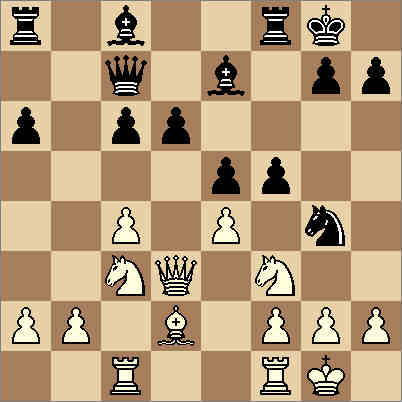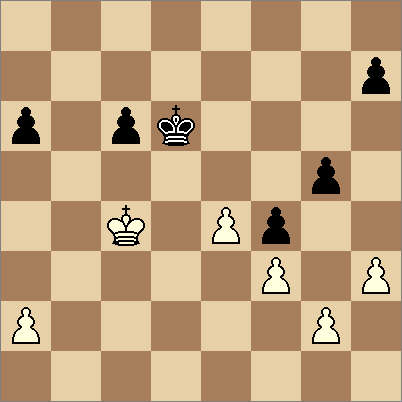
Worcester & District Chess League

Bennett Cup Final 2009
Annotations by Andrew Farthing The moves of the Final of the Bennett Cup are below, with the time in minutes remaining after each move in brackets. The comments are mine, so they are bound to be much less accurate than either of the players could offer. Still, this will give the reader the additional fun of spotting all of my errors and misjudgements!
Brian Turner – Maurice Bissell. Kidderminster, 2009
1.e4 (74) c5 (75) 2.Nf3 (74) Nc6 (74) 3.Bb5 (73)
I perked up when I saw this. The Bb5 Sicilian used to be part of my White repertoire, so I was looking forward to seeing how the two maestros would handle the opening.
3...a6?! (74)
So much for theory. 3...e6 and 3..g6 are standard responses, with 3...Nf6 joining their ranks as a more double-edged try. Maurice chooses an unusual line, but given that White wants to swap on c6 anyway in this variation, it looks like a loss of tempo.
4.Bxc6 (73) bxc6 (74) 5.d4 (70)
Brian reciprocates with a rare move of his own. 5. 0-0 would offer White the prospect of a “main line” Bb5 Sicilian with a move in hand (since White often plays Bxc6 without waiting for ...a6). In the end, it probably doesn't make a huge difference.
5...cxd4 (72) 6.Qxd4 (70) d6 (70) 7.c4 (67) e5 (68) 8.Qd3 (64) Nf6 (66) 9.Nc3 (61) Qc7 (64 ) 10.0–0 (60) Be7 (63) 11.Be3 (56)
At this stage, my feeling was that White's extra space offset the potential of Black's two bishops and that the position was roughly equal.
11...0–0 (59) 12.Rac1 (53)
Throughout the game, I was indulging in the well-known game of ‘Predict-a-Move'. Worryingly for Brian, I suspect, I had successfully predicted each of his moves since 5. d4, but this came as a surprise. With the benefit of hindsight (or, in Brian's case, foresight), it's a good move. The rook's presence on the c-file will prove very handy as the game progresses.
12...Ng4! (55)
Natural and strong. White can't afford to exchange both bishops for knights.
13.Bg5 (50) f6 (52) 14.Bd2 (46)
14.Bh4 might look more natural at first sight, but I'm not convinced that the bishop is best placed on the kingside.
14...f5! (50)
By now, I was starting to like Black's position. It's looking increasingly likely that the Black bishops are going to become more active (e.g. after ...fxe4, clearing the light-squared diagonal. The fact that Brian now sank into deep thought tended to confirm the impression that this was the first critical position of the game.
Position after 14…f5! Turner, to move playing white, has a choice of three excellent moves against Bissell |
 |
15.c5! (29)
Brian actually made this move after 12 minutes' thought, but upon emerging from his trance he forgot to press his clock. Maurice was equally absorbed in the game, so it was only after 5 more minutes that Brian noticed. Testifying to the sporting spirit on show, Maurice promptly apologized for not noticing himself and letting his opponent know. The long think resulted in a good move, although there is at least one other interesting possibility. 15. Nd5! puts the knight en prise , but White has a nice little tactic: 15...cxd5 16.Qxd5+ Kh8 17.Qxa8. The resulting position is still rather complicated and I suspect that Black has compensation for the material. In this line, 15...Qb7 is equal.
15...dxc5 (46)
At the time, I thought that 15...fxe4 was stronger, but Brian told me after the game that he intended 16. cxd6, which looks fine for White.
16.Qc4+ (28) Kh8 (45) 17.Rfe1 (25) 17...f4? (43)
I was very surprised to see this. Now that Black no longer has pressure on White's e-pawn, I couldn't see past Black's horrible pawn structure. I think Black is definitely worse now. However, any smugness I might be tempted to feel is immediately swept away by the realization that the move I preferred while watching the game live was the lousy 17...fxe4?!, which is much weaker than two moves ago. My trusty friend Fritz suggests 17...Rb8, which it evaluates as close to equal.
18.Na4 (23) Rf6 (38) 19.Nxc5 (22) Rg6 (35)
A typically crafty move. The rook may not seem to have much future here, but there are always tactical possibilities in the air if White drives the knight away with h2-h3, when a future ...Bxh3 may be an option.
20.b4 (20) Qd6?! (33)
I'm sceptical about this. I assume that the intention was (as duly transpires) to play ...Be6 and effectively force White to give up the well-placed knight on c5. However, my superficial view was that exchanges were only going to increase White's winning chances, particularly when combined with the loss of the bishop pair. 20...a5!? might be more promising, with a view to developing the bishop to a6 instead. This isn't the sort of position that computer programs evaluate reliably, but it's interesting to note that Fritz consistently assesses the positions after this move as winning for White, whereas it was only “better for White” after 17...f4? (which I suspected might be the losing move). On this basis, perhaps 20...Qd6 is the small inaccuracy that tips Black over the edge. That said, it's far from straightforward, and White is well behind on the clock, which complicates his task.
21.Bc3 (19)
White is bound to pick up a pawn now.
21...Be6 (29) 22.Nxe6 (19) Qxe6 (27) 23.Qxe6 (18) Rxe6 (27) 24.h3 (18) Nf6 (25) 25.Nxe5 (17)
Warning – Smugness Alert! I spotted during the game the possibility of 25.Ng5! when 25...Rd6 26.Nf7+ Kg8 27.Nxd6 Bxd6 leaves White in a winning position. Now, it gets tricky again.
25...Kg8 (23) 26.Nd3 (14) g5 (18) 27.f3 (13) Rd8 (17) 28.Red1 (12) Nd7 (12)
Maurice gave considerable thought to this, bringing the clock times temporarily back to parity. It's a very difficult endgame to assess. Relocating the knight to the queenside looks like the most natural and promising plan, but after this move it's hard to see where Black's drawing chances lie. The mighty Fritz prefers 28...Red6!? when 29.Nb2 Rxd1+ 30.Nxd1 Nh5 is assessed as better for White but not quite winning. (At about this time, the bartender appeared and asked how long the game was going to last, as he was due to close the club in a quarter of an hour. Fortunately – given that I had no idea how we would have satisfactorily adjourned a game with just 25 minutes left per player – the barman very kindly agreed to let the game carry on to its conclusion.)
29.Kf1 (9) Nb6 (10) 30.Nc5 (6) Rxd1+ (10) 31.Rxd1 (6) Bxc5 (9) 32.bxc5 (5) Nc4 (9) 33.Bd4 (3)
This surprised me. I expected Brian to move the rook to a more active square first with 33.Rd8+ and only then 34.Bd4. It shouldn't affect the outcome.
33...Re8 (8) 34.Ke2 (2) Rb8 (7) 35.Rc1 (1)
Phew! Making it to the time control with seconds to spare. For what it's worth, Fritz suggests that 35.h4!? makes it the task easier for White, e.g. 35...Rd8 36.hxg5 Kf7.
35...Na3 (5) 36.Be5 (12)
Having reached the time control and gained the additional 15 minutes, Brian took several minutes to compose himself and take a considered look at the position. In particular, he needed to work out the prospects for the king and pawn ending if all the pieces are exchanged.
36...Rb7 (19) 37.Kd3 (12) Kf7 (18) 38.Rc3 (10) Rd7+ (15) 39.Bd6 (10)
Somewhat bizarrely, Fritz suggests that this is an error (it prefers 39. Ke2) and evaluates the position after Black's next move as only ‘better for White'. However, it then fails to identify any improvements for Black which lead to anything better than ‘winning for White'. Computers! Don't you just love them?
39...Nb5 (15) 40.Rc4 (9) Nxd6 (14)
Fritz call this an error, preferring 40...Ke6 41.a4 Na7 42.Rd4. However, it still assesses this as winning for White, so I have to wonder what difference it makes.
41.Rd4 (8) Ke7 (11) 42.Rxd6 (8) Rxd6+ (10) 43.cxd6+ (8) Kxd6 (10)
Position after 44.Kc4. Bissell, playing black, is faced with a lost king and pawn ending against Turner |
 |
44.Kc4 (8) h5 (8)
Black has a choice of pawn moves, but unfortunately there's no hope left now. The writing is most definitely on the wall now.
45.a4 (7) a5 (4) 46.Kd4 (7) c5+ (4) 47.Kc4 (7) Kc6 (2) 48.e5 (6) h4 (2) 49.e6 (5) Kd6 (1) 50.e7 (5) 50...Kxe7 (1) 51.Kxc5 (5) 1–0
At this point, Maurice's flag fell. The endgame is completely hopeless for Black. A very well contested game, which I greatly enjoyed watching. Maurice put up a stubborn resistance in defence of the Cup, while Brian's unflustered play in a difficult position was the sign of a worthy champion.